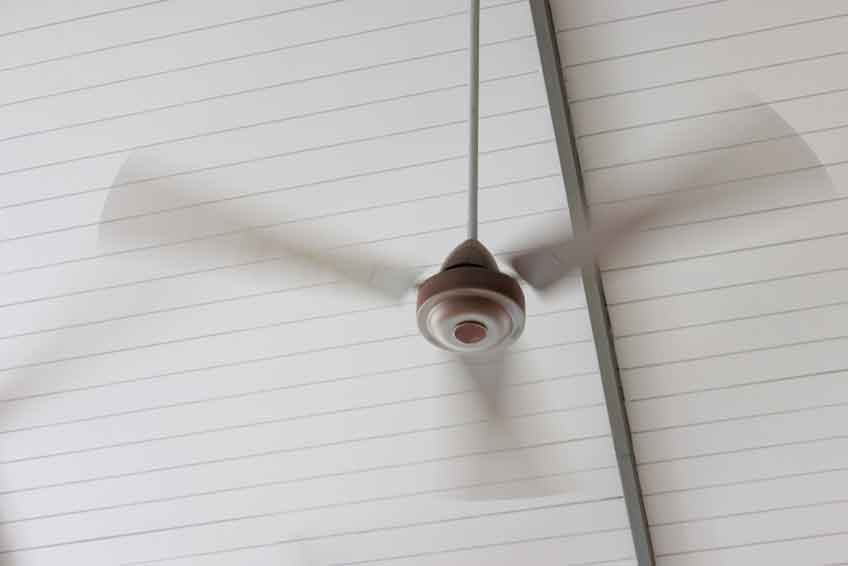There are plenty of hot days left and ceiling fans can be a great way to beat the heat without busting your budget. But did you know that the right ceiling fan in the right place can also save on your winter heating bills?
Here are some tips to get the most out of your ceiling fan(s) throughout the year.
Pick the Right Fan
Before considering a ceiling fan, bear in mind that the blades must be at least seven feet above the floor to be safe. The blades should also have 10” or more clearance from the ceiling. That means that the ceiling needs to be at least 8 feet high to operate safely and efficiently. In rooms with high ceilings, use an extender that keeps the blades 9-10 feet from the floor for best efficiency.
Since a ceiling fan becomes part of the room’s décor, choose a style that fits your design taste so that it’s a pleasant visual addition to the room.
Size Matters
Blade span (the diameter of the blades’ arc) should be considered when choosing a ceiling fan. Generally speaking, blade span affects the fan’s efficiency. Too small and the fan won’t move enough air; too large and the breeze can be uncomfortable.
Blade spans of 44-50 inches are suited well to rooms between 150 and 225 square feet. Larger rooms may do better with multiple fans for the best coverage.
Perfect Pitch Matters, Too
For blades to move the air properly, the angle of the blade relative to the fan (the blade pitch) makes a difference. The optimum pitch 12-14 degrees. Too great a pitch will cut down circulation and too narrow a pitch moves too little air. Either can cause the fan’s motor to overwork, wasting energy and causing premature failure.
The Goal is Efficiency
You’re installing the fan to save money, so look for a fan with a high efficiency rating. Fans are rated on how much air they move per unit of energy consumed. The flow is measured in cubic feet per minute (CFM) and energy is measured in how many watts are needed per CFM of air moved. Look for a fan rated from 4,000 to 6,000 CFM for best efficiency.
The US Department of Energy estimates that using a ceiling fan during the summer lets you raise you’re A/C by around 4°F. Manufacturers claim that running a ceiling fan at low speeds in winter can save up to 15% on heating bills.
Direction Makes a Difference
To get the best out of a ceiling fan, you need to change the direction of the airflow seasonally. This is done by reversing the rotation of the blades to move air downward in warm weather and upward in the cold. The downward flow creates a cooling breeze while moving air upward allows heavier cool air to mix with warm air trapped near the ceiling directing it into the lower parts of the room. Typically, the blades rotate counterclockwise for cooling and clockwise for warming.
Many fans come with a switch on the fan motor to change the blades’ direction as well as a switch or pull chain to control the fan speed. Others come with wall-mounted controls. Some can even be controlled remotely by a controller, even by your phone via your home’s Wi-Fi network. It’s up to you to decide how fancy (and expensive) a setup you want.
Consult your owner’s manual for how to change direction and speed safely for your particular model.
Tip: Use your seasonal change of direction as a reminder to clean your fan blades according to your manufacturer’s recommendations.
Location Plays a Role
Ceiling fans are long-term installations, so take some time to be sure they’re in the right location for the best function and safety.
If your fan includes a light fixture, you’ll want it to shine where you want it. Just remember that the fan moves with the light so prioritize the fan location. You can always turn off the light and keep the fan running.
Furniture placement also needs consideration. Tall pieces can block air flow and if they’re too close to the fan, they can also present irresistible temptation to cats and other frisky pets.
Placing a fan where arms may be flailing, such as changing clothing or exercising, can be a safety hazard to people, as well. And do you want the fan blowing directly onto your bed or dinner table? Maybe, maybe not.
Don’t Take Chances. Call a Pro
Installing a ceiling fan may seem like a simple DIY project, but don’t risk your comfort and safety by overlooking important electrical work and design considerations to make your seasonal improvements function at their best. Allstar Electrical Services delivers the expertise and quality results you expect and deserve, whatever your needs may be. We’ve served the Front Range for over 20 years, are top-rated by the Better Business Bureau and are proud to be listed as a preferred contractor by Angie’s Home Advisor. Just give us a call at 303.399.7420 or visit our website. Then use our handy online forms to request a free estimate or set up an appointment.


